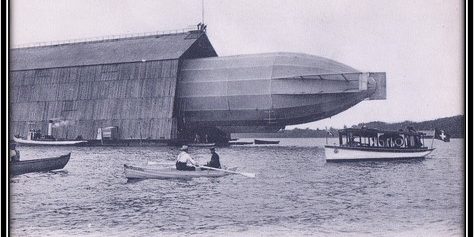On this day in aviation history: German zeppelin L-4
Contributor: Barry Fetzer
Sources: History.com
My Aunt Ann who died recently in Fort Smith at age 93 was our family matriarch, my mom’s sister, and one of two daughters of my maternal grandfather, Theophil Tröhler, his first name Americanized to Ted when he immigrated to the US.
Aunt Ann’s aunt…my great Aunt Anna (we called her “Tante” {meaning “aunt” in German} Anna even into adulthood)…was born in Germany and emigrated to the US before WWII along with her brother (my maternal grandfather, Ted).
The two of them left their mother and father and a sister and four brothers in Germany (the boys ultimately fighting for Germany during WWII—one missing in action at the end of the War and presumed dead) and Anna and Ted both defied Hitler’s orders for all “good Germans” to return to the Fatherland as the winds of war were blowing across Europe in the late 1930’s.
My Tante Anna was old enough to remember WWI in Germany before she also lived through WWII (in America) and wrote about one of her WWI experiences. She was writing about the fear of war that ultimately drove her to emigrate to the US and the bombings her town (Freiburg), endured during WWI, the rationing and hunger she experienced, and the sickness and injuries in her family. She wrote, “It was Kaiser Wilhem’s birthday in 1916. Thirty-one bombs fell. It was about 30 airplanes and a zeppelin. Our four-story apartment house shook and the windows rattled as the bombs fell around us.”

My Tante Anna in 1992. Fetzer Family Photo.
Anna experienced, it seems from her writing, English and French retaliation for what German zeppelins had done to Great Britain and France. Despite her fear she survived. And blessedly I would say, so we could know and love our Great Aunt from Germany, our Tante Anna.
But flying and crewing these gas bags, whether they were airships from Britain or zeppelins from Germany were fraught with risks, even outside of combat.
According to History.com, “After encountering a severe snowstorm on the evening of February 17, 1915, the German zeppelin L-4 crash-landed in the North Sea near the Danish coastal town of Varde.
“The zeppelin, a motor-driven rigid airship, was developed by German inventor Ferdinand Graf von Zeppelin in 1900. Although a French inventor had built a power-driven airship several decades before, Zeppelin’s rigid dirigible, with its steel framework, was by far the largest airship ever constructed.

Postcard photo of the zeppelin L-4. Courtesy dingeengoete.blogspot.com.
“The L-4‘s captain, Count Platen-Hallermund, and a crew of 14 men had completed a routine scouting mission off the Norwegian coast in search of Allied merchant vessels and were returning to their base in Hamburg, Germany, when the snowstorm flared up, bombarding the airship with gale-force winds.
“Unable to control the zeppelin in the face of such strong winds, the crew steered toward the Danish coast for an emergency landing, but was unable to reach the shore before crashing into the North Sea. The Danish coast guard rescued 11 members of the crew who had abandoned ship and jumped into the sea prior to the crash; they were brought to Odense as prisoners to be interrogated. Four members of the crew were believed drowned and their bodies were never recovered.
“One month earlier, the L-4 had taken part in the first-ever air raid on Britain in January 1915, when it and two other zeppelins dropped bombs on the towns of Great Yarmouth and King’s Lynn on the eastern coast of England. Four civilians were killed in the raid, two in each town. Zeppelins would continue to wreak destruction on Germany’s enemies throughout the next several years of war–by May 1916, 550 British civilians had been killed by aerial bombs.”

British propaganda postcard, entitled ‘The End of the ‘Baby-Killer’ depicting the end of a German zeppelin. Courtesy Wikipedia.







